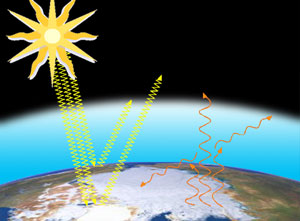|
|
 |
|
|
|
 |
| |
|
|
 |
How are
people changing
the climate?
Basics |
1. Man-made climate change?
For the first time in human history, people are changing the Earth’s climate by emitting so-called greenhouse gases to the atmosphere. The main cause is the dramatic increase in the use of fossil fuels (coal, oil and natural gas) since the Industrial Revolution.
|
|
|
|
|
 |
Past climate change
The Earth’s climate has always been changing. Only 20,000 years ago, much of Northern Europe was still covered in an enormous glacier that was up to three kilometers thick! The Alps and the Pyrenees mountains were covered with smaller ice caps. Sudden climate shifts happened quite frequently during the Ice Age, and made the ice expand or contract. In the cold climate south of the ice-covered areas, small groups of people hunted reindeer, wild horses, and bison.
|
People living in the Ice Age left behind stone tools and fantastic cave paintings. But their way of life was about to disappear. Over thousands of years, the Earth’s orbit around the sun changed so that the summers became warmer, and the ice began to melt. The Ice Age ended around 10,000 years ago. Since then, the climate in Northern Hemisphere has been warmer and far more stable. Over the last 10,000 years of milder climate, people developed agriculture, cities, and civilization – which would have been far more difficult during the Ice Age.
|
 |
 |
 |
|
1. CAVE PAINTING: Painting of a wild horse from the Lascaux cave in France, painted about 12,000-17,000 years ago. When the Ice Age ended, people’s way of life changed and they stopped making cave paintings.
Photo: Artchive.com (click to enlarge, 75 kB)
|
|
|
We will always be at risk of unexpected and unpleasant climate changes from natural causes. For example, around 400 years ago Europe experienced a relatively cold period called the Little Ice Age (it was not as cold as a real ice age). What is different about the situation today is that we risk rapid changes in climate caused by people. Because of our increasing emissions of CO2 and other greenhouse gases, we expect that over the next hundred years we will see that fastest warming of the Earth since the end of the Ice Age.
|
From local to global problems
As long as we humans have existed on Earth, we have affected the environment around us. But in the past, the effects of our hunting or agricultural activities were basically local. This changed with the Industrial Revolution that began round 1750 and accelerated in the 1800s and 1900s. A revolution is a dramatic social change.
|
 |
 |
|
2. FOSSIL FUELS: Before the industrial revolution, all ships were powered by oars or sail. The first ships with an engine were powered by steam engines, which were fired by coal. Photo: The NOAA Photo Library (click to enlarge, 140 kB)
|
|
 |
The Industrial Revolution took place when people began to mass produce goods in large factories using machines that ran on energy from coal, and later, oil, natural gas, and electricity. This made it much easier for people to produce goods, and helped the development of modern technology. In pre-industrial times – that is, the time before the Industrial Revolution – there were no trains, cars, planes, electric lights, factories, telephones, or televisions.
The more we produce and consume, the more we affect the environment around us. During the last 50 years, for the first time in history we have seen clear signs that human influence affects the environment of the entire planet; we are creating environmental problems that are not only local but also global. One of these global environmental problems is the risk of man-made climate change, also known as global warming.
|
Global climate change
Man-made climate change occurs because we emit greenhouse gases to the atmosphere. These emissions come from many sources, including the factories and agriculture that supply us with food and other material goods, power plants that provide us with electricity, and cars and planes that take us where we need to go.
|
Greenhouse gases affect the Earth’s climate by increasing the greenhouse effect, which is a natural phenomenon whereby water vapor, CO2, and other gases in the atmosphere allow sunlight to pass through, but then absorb much of the heat from the earth that otherwise would have escaped to outer space. Without the natural greenhouse effect, the mean temperature would be about minus 18°C, and the Earth would be uninhabitable (choose the topic Lower atmosphere if you want to read more about the greenhouse effect).
Emitting greenhouse gases in large amounts increases the concentration of these gases in the atmosphere, which then increases the greenhouse effect so that more heat is trapped by the atmosphere. This can increase the temperature of the atmosphere and change the climate on Earth.
|
 |
 |
 |
|
3. THE GREENHOUSE EFFECT: Sunshine (visible light) enters the atmosphere freely (yellow radiation in the left side of the figure). Some of it is immediately reflected by clouds, dust in the atmosphere and shiny surfaces (yellow radiation in the middle of the figure). The rest heats the Earth. Greenhouse gases in the atmosphere slow down the escape of heat back to outer space (red radiation in the figure). Image: CICERO/Petter Haugneland (Click to enlarge, 56 kB)
|
|
Next page
Author: Camilla Schreiner - CICERO (Center for International Climate and Environmental Research - Oslo) - Norway. Scientific reviewers: Andreas Tjernshaugen - CICERO (Center for International Climate and Environmental Research - Oslo) - Norway - 2004-01-20 and Knut Alfsen - Statistics Norway - Norway - 2003-09-12. Educational reviewer: Nina Arnesen - Marienlyst school in Oslo - Norway - 2004-03-10. Last update: 2004-03-27.
|
|
 |
|









